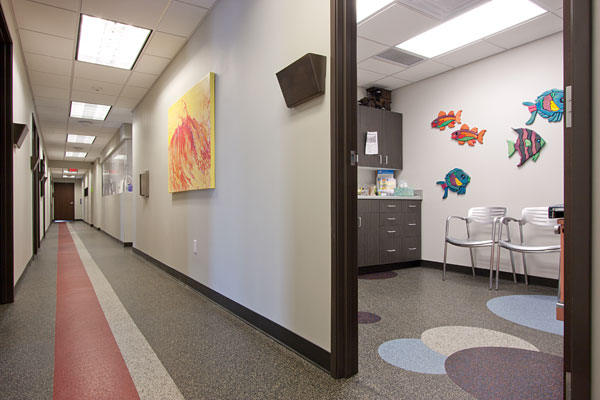New Trends in Resilient Flooring for Healthcare Environments
Not long ago every floor in a hospital might be covered with a single material, often the same sterile institutional color. It was probably noisy and hard, with no particular connection to the mission of the facility. Now there are specialized resilient flooring solutions available for every application.
This course will consider three important factors in selecting a resilient floor for a healthcare environment: current construction and design trends, the evidence-based performance requirements of each space, and the different types of resilient flooring that are available, including new technology that is transforming familiar products and creating new options.
Floors for New Spaces
The growth in healthcare construction is centered in new outpatient settings and new specialized spaces within existing hospitals. Medical services are being relocated to the community as part of a population-based approach to medicine. The formation of new Accountable Care Organizations (ACOs), where voluntary groups of primary physicians, specialists, and hospitals work together to provide patients with coordinated, integrated care, often brings new outpatient units into partnership with larger hospital systems.
Buildings originally built for other purposes are being renovated to become neighborhood primary care or urgent care clinics (for example, the Formé Urgent Care and Wellness Center building, featured in a sidebar in the online version of this course, previously housed the White Plains Building Department). Some ambulatory care centers (ACCs) offer all the services available in an acute care hospital with the exception of overnight stay. They are far faster and less expensive to build than new hospital wings, and can be designed for flexibility and expansion if markets grow or change.
Within hospitals, spaces are being reconfigured to improve processes, to meet new purposes, and to make changes that will lead to lower costs in cleaning, maintenance, and energy. The 2015 Hospital Construction Survey1 indicates that “more than half of hospitals and health systems are repurposing space, or considering the idea, as they transition to value-based payment models and take the reins of population health management in their communities.”
Examples of this trend include:
► Stand-alone emergency departments
► Ambulatory surgery centers
► Medical offices for targeted procedures
► Specialized services, e.g., dialysis, infusion
► Community primary and urgent care centers
► Behavioral health units
► Bariatric care
► Acuity-adaptable rooms
► Rehabilitation and physical therapy centers
► Diagnostic and imaging centers
Facilities like ACCs combine areas for different purposes, and require specific flooring for each. Treatment and procedure rooms require the same seamless germ-free flooring as a sterile hospital operating room. Laboratories and imaging facilities may require flooring that controls electrostatic discharge (ESD).
All require ergonomically effective and easy-to-clean patient rooms and staff areas, noise-dampening corridors, cost-efficient utility and pharmacy areas, and waiting and consultation areas that are welcoming and reduce stress. As discussed later in this course, research has shown that “waiting” is an activity that can have a significant impact on family engagement and patient outcomes. In fact, the attractiveness of the lobby has been found to affect a patient's perception of the quality of care, even including the length of the wait.
Renovation within hospitals often concentrates on reconfiguring and equipping space for better workflow and to meet new priorities in care.
For example, evidence indicates that many patients have better outcomes in single rooms, and when they can stay in one room throughout the different stages of their care. This is known as “acuity adaptable.” These rooms are equipped with sources of power and medical gases, but portable equipment can be moved in and out for every purpose from bedside diagnostics to critical care. This offers the patient quality care with minimum time and effort spent waiting, preparing, and being moved around to other sections of the hospital. Rooms like this require flooring that is durable, adaptable, easy to clean on a daily (or hourly) basis, and able to withstand heavy equipment without damage or indentations, while providing roller mobility and allowing staff to maneuver equipment easily.
Parallel to the growing shift towards the integrated ACO model of healthcare is a more holistic, preventative approach that extends the concept of healthcare beyond its traditional definition as treatment for emergency or disease. Rehabilitation and physical therapy areas meet the needs of the large segment of the population getting joint replacements and other procedures, but they also respond to an emphasis on healthcare for wellness as opposed to medical intervention. Specialized resilient flooring is required for weights, heavy equipment, pools, and water therapy.
Behavioral health units, whether in psychiatric facilities, specialized hospital units, or drug and alcohol rehabilitation centers, require calming, soothing interiors, including cushioned floors and sound dampening for floors, walls, and ceilings to relieve patient anxiety and agitation.2 These materials must also resist being ripped up or used by patients to injure themselves or others. An example is flooring with impact-resistant bonded construction and superior peel strength.
Flooring in bariatric rooms that provide the special care and equipment needed for the increasing number of obese patients must not deform or peel. Facilities focusing on the needs of the elderly, such as new geriatric emergency departments designed for the 15-20 percent of emergency room patients over 65, require slip-resistant safety flooring, increased lighting, and attention to wayfinding.
Different types of flooring may be required not only in the same building, but at times within the same space. For example, different textures and colors can be used to indicate level changes to assist in wayfinding or to help prevent stumbles and falls.

Photo courtesy of Ecore Commercial Flooring
Healthy Outlook Family Medicine, P.C., located in Phoenix, Arizona. Studies indicate that the attractiveness of the surrounding, as in this exam room with recycled rubber flooring, has a positive impact on patient perceptions about quality of care.









